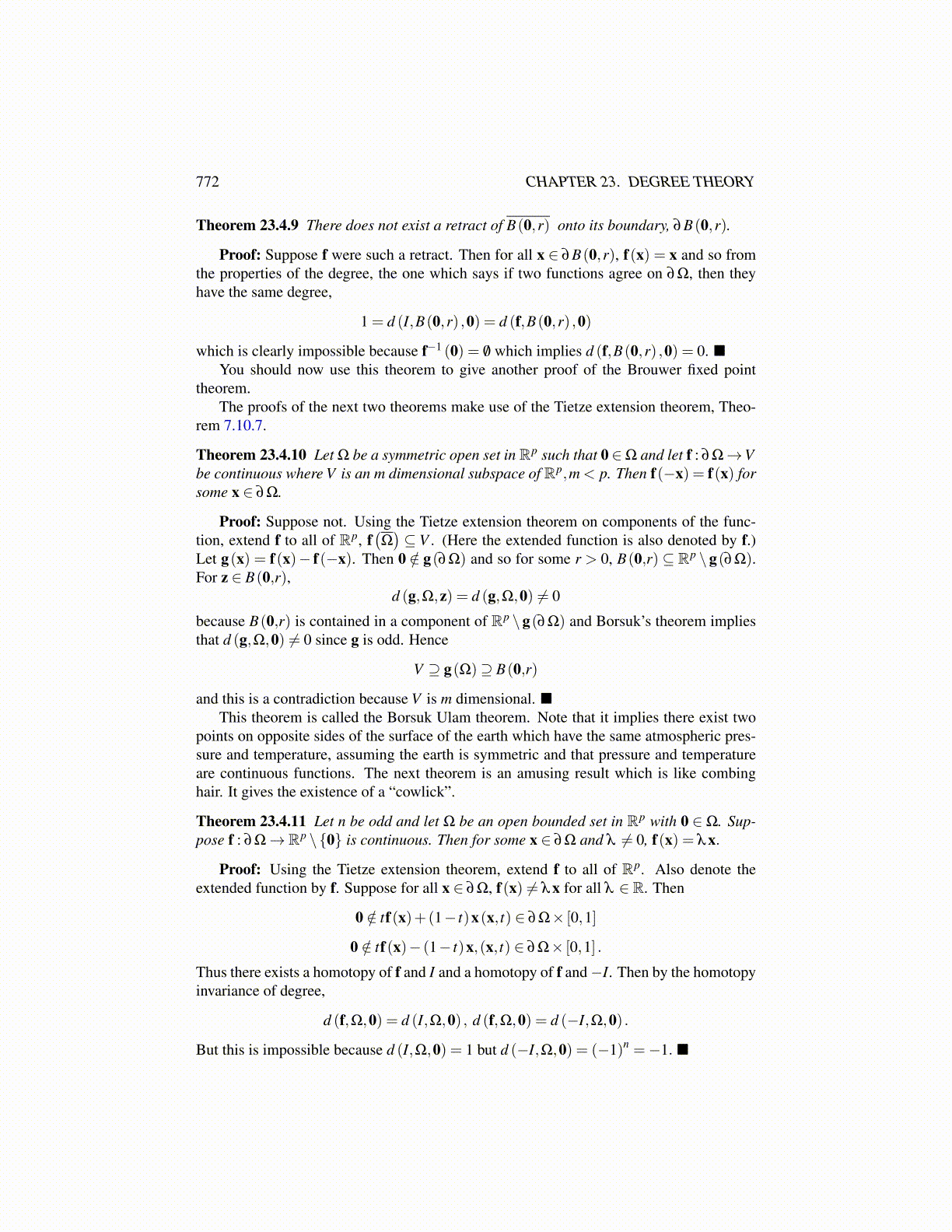
772 CHAPTER 23. DEGREE THEORY
Theorem 23.4.9 There does not exist a retract of B(0,r) onto its boundary, ∂B(0,r).
Proof: Suppose f were such a retract. Then for all x ∈ ∂B(0,r), f(x) = x and so fromthe properties of the degree, the one which says if two functions agree on ∂Ω, then theyhave the same degree,
1 = d (I,B(0,r) ,0) = d (f,B(0,r) ,0)
which is clearly impossible because f−1 (0) = /0 which implies d (f,B(0,r) ,0) = 0.You should now use this theorem to give another proof of the Brouwer fixed point
theorem.The proofs of the next two theorems make use of the Tietze extension theorem, Theo-
rem 7.10.7.
Theorem 23.4.10 Let Ω be a symmetric open set in Rp such that 0 ∈Ω and let f : ∂Ω→Vbe continuous where V is an m dimensional subspace of Rp,m < p. Then f(−x) = f(x) forsome x ∈ ∂Ω.
Proof: Suppose not. Using the Tietze extension theorem on components of the func-tion, extend f to all of Rp, f
(Ω)⊆ V . (Here the extended function is also denoted by f.)
Let g(x) = f(x)− f(−x). Then 0 /∈ g(∂Ω) and so for some r > 0, B(0,r) ⊆ Rp \ g(∂Ω).For z ∈ B(0,r),
d (g,Ω,z) = d (g,Ω,0) ̸= 0
because B(0,r) is contained in a component of Rp \g(∂Ω) and Borsuk’s theorem impliesthat d (g,Ω,0) ̸= 0 since g is odd. Hence
V ⊇ g(Ω)⊇ B(0,r)
and this is a contradiction because V is m dimensional.This theorem is called the Borsuk Ulam theorem. Note that it implies there exist two
points on opposite sides of the surface of the earth which have the same atmospheric pres-sure and temperature, assuming the earth is symmetric and that pressure and temperatureare continuous functions. The next theorem is an amusing result which is like combinghair. It gives the existence of a “cowlick”.
Theorem 23.4.11 Let n be odd and let Ω be an open bounded set in Rp with 0 ∈ Ω. Sup-pose f : ∂Ω→ Rp \{0} is continuous. Then for some x ∈ ∂Ω and λ ̸= 0, f(x) = λx.
Proof: Using the Tietze extension theorem, extend f to all of Rp. Also denote theextended function by f. Suppose for all x ∈ ∂Ω, f(x) ̸= λx for all λ ∈ R. Then
0 /∈ tf(x)+(1− t)x(x, t) ∈ ∂Ω× [0,1]
0 /∈ tf(x)− (1− t)x,(x, t) ∈ ∂Ω× [0,1] .
Thus there exists a homotopy of f and I and a homotopy of f and−I. Then by the homotopyinvariance of degree,
d (f,Ω,0) = d (I,Ω,0) , d (f,Ω,0) = d (−I,Ω,0) .
But this is impossible because d (I,Ω,0) = 1 but d (−I,Ω,0) = (−1)n =−1.